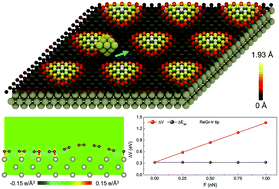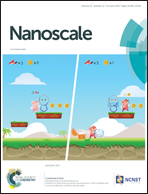Origin of the moiré superlattice scale lateral force modulation of graphene on a transition metal substrate†
Abstract
The moiré superlattice formed between graphene and a transition metal substrate is capable of tuning the frictional properties of graphene. For instance, a moiré superlattice scale modulation on the lateral force will be experienced by the tip of an atomic force microscope (AFM). However, the origin of this long-range force modulation still needs to be clarified. In this study, density functional theory (DFT) calculations have been carried out to investigate the indentation processes of a one-Ar-atom tip and a 10-atom Ir tip, sliding on graphene/Re(0001) and graphene/Pt(111) moiré superlattices, respectively. The calculation results indicate that the interfacial interaction between graphene and a transition metal substrate determines the morphological corrugation of graphene and the characteristics of the lateral force modulation. Moreover, when the tip–graphene interaction is strong enough, it will influence the evolutions of the adsorption energy Ead and tip sliding trajectory. Thus, the moiré superlattice scale lateral force modulation of graphene on a transition metal substrate originates from the joint effects of the graphene–substrate interfacial interaction and tip–graphene interaction.



 Please wait while we load your content...
Please wait while we load your content...